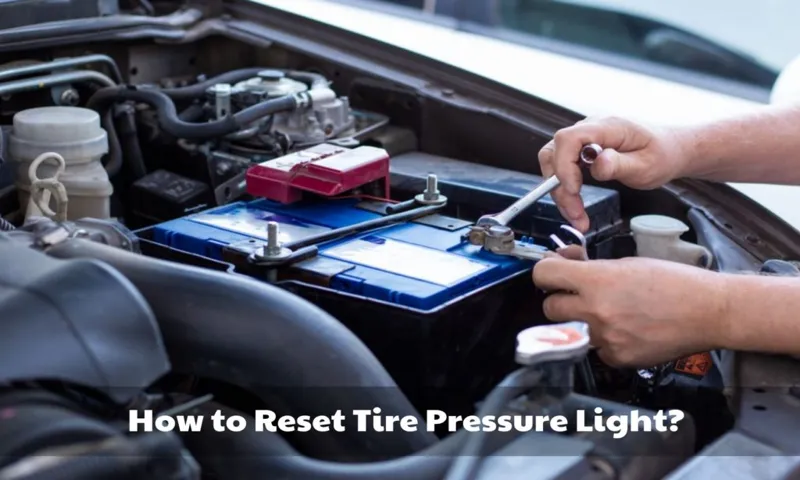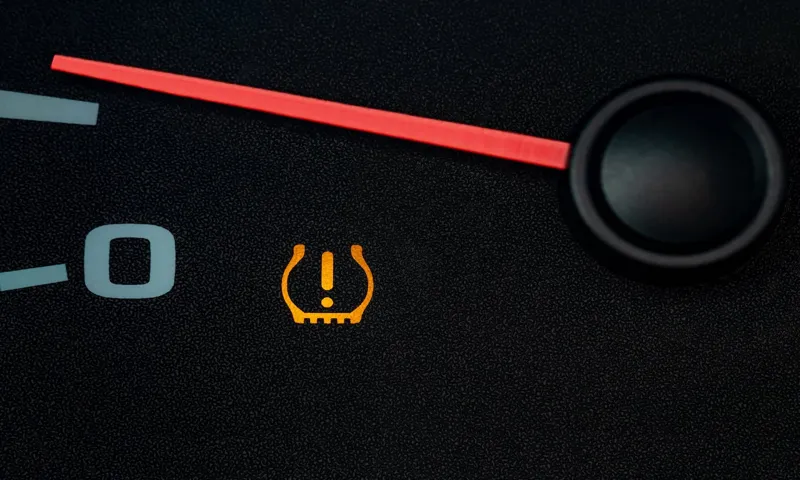Have you ever been driving down the road, minding your own business, when suddenly the tire light on your dashboard starts blinking? It’s a frustrating and confusing experience, especially if you’re not sure what’s causing it. But don’t worry, you’re not alone. Many drivers experience this issue, and there are a few reasons why it might be happening.
In this blog, we’ll explore the reasons behind a blinking tire light and what you can do to fix it. So sit tight, and let’s dive in!
Table of Contents
Possible Causes
If your tire light is blinking on your dashboard, it could be due to a variety of reasons. One possible cause is low tire pressure. When the tire pressure is low, it can cause the light to blink as a warning to indicate that the tire needs to be inflated.
Another cause could be a damaged tire or a puncture. If there is a hole or puncture in the tire, it could cause the tire light to blink to alert you of the issue. In addition, a malfunctioning sensor could also be the cause of a blinking tire light.
The sensor is responsible for detecting the tire pressure and if it is faulty, it can send an incorrect signal to the dashboard, causing the light to blink. It’s important to have your car checked by a professional to determine the root cause of the problem to prevent any potential issues that could arise from driving with a blinking tire light.
Low tire pressure
Low tire pressure can be quite frustrating for drivers, and it’s one of the most common issues that automobile owners face. There are a number of reasons why your tire pressure may be low, with the most obvious being that you’re due for a tire change. However, there are several other factors that can cause low tire pressure as well.
For instance, extreme temperatures can cause the air in your tires to expand or contract, leading to a decrease in tire pressure. Another common reason why tire pressure drops is due to punctures or leaks in the tire. In addition, tire valves may be damaged or faulty, leading to a decline in air pressure.
Improperly seated tires or wheels may also cause low tire pressure. It’s wise to regularly check your tire pressure and ensure that it’s always at the recommended level to avoid any safety hazards. By keeping an eye on your tire pressure, you’ll save yourself the trouble of dealing with flats or blowouts, and you’ll also save money on fuel.

Leaking tire
A leaking tire can be a frustrating and dangerous issue, especially when driving on the highway. There are several possible causes for a tire leak, including damage to the tire’s sidewall or tread, a puncture by a sharp object on the road, or a faulty valve stem. It’s crucial to identify the cause of the leak to determine the best course of action.
A professional tire technician can inspect the tire for any visible signs of damage and perform a pressurized leak test to detect any hidden punctures or leaks. In some cases, a simple patch or plug can fix the issue, but if the tire is severely damaged, it may need replacement. It’s essential to address a leaking tire promptly as it can lead to decreased fuel efficiency, reduced traction, and even a blowout while driving.
Overall, regular tire maintenance and inspections can help prevent tire leaks and ensure safe driving.
Faulty tire sensor
The faulty tire sensor is a common issue faced by many drivers. There are several possible causes for this problem. One of the main reasons is a dead battery in the sensor itself.
A malfunctioning sensor battery can cause communication issues between the sensor and the onboard computer system. Another reason could be a damaged, corroded or loose sensor stem, which can cause poor communication or no communication at all. A malfunctioning receiver unit in the onboard computer system could also be a possible cause, where the system may fail in capturing the signals of the sensor.
Finally, it could be due to environmental factors such as extreme heat or cold, which can damage the sensor or its connections. All of these are possible causes that can be tackled by a skilled mechanic. A professional with the right tools and skills can efficiently diagnose and fix the issue.
In conclusion, timely maintenance can prevent this problem from occurring, but in the event of a faulty sensor, it is best to get a professional’s help.
What to do
If you’re wondering why your tire light is blinking, don’t panic. This warning signal can indicate several issues with your car tire, including low tire pressure or a malfunctioning tire pressure sensor. First, check your tire pressure with a pressure gauge and ensure it’s within the recommended range.
You should also examine your tires for any visible damage like punctures or tears. If you can’t find any visible damage, then it’s likely that the pressure sensor isn’t working correctly. In such cases, take your vehicle to a trusted mechanic to get it checked.
Don’t take your tire pressure light lightly, as it could result in reduced gas mileage, tire wear, or even jeopardize your safety on the road. Keep a check on your tire pressure and replace worn-out tires or sensors when necessary.
Check tire pressure
Checking tire pressure regularly is crucial in ensuring the safety and longevity of your vehicle. The process is easy and can be done at home or at a gas station. To begin, locate the tire pressure recommendation in your car’s owner’s manual or on the driver’s side door jamb.
Remove the valve cap from the tire and place the tire pressure gauge onto the valve stem. The gauge will measure the pressure and display the reading. Compare the reading to the recommended pressure and adjust the tire pressure as needed.
Overinflated tires can cause a bumpy ride, while underinflated tires can lead to poor fuel efficiency and even tire blowouts. Checking your tire pressure regularly can save you money on gas and reduce the risk of accidents on the road. Remember, your tire pressure should be checked at least once a month to ensure optimal safety and performance.
Inspect tires
Inspecting your tires regularly is crucial to ensure that they are in good condition and safe to use. So, what should you do when inspecting your tires? First, you need to check their overall condition. Look for any cuts, punctures, or bulges on the sidewalls or treads.
These can be indications of potential problems that may cause tire failure. Another thing to check is the tread wear. The tread should not be less than 1/16 of an inch deep.
Otherwise, it’s time to replace your tires. Don’t forget to look for any unusual wear patterns, as they can indicate problems with your vehicle’s alignment or suspension. It’s also essential to check the tire pressure regularly.
Proper inflation ensures your tires perform optimally, providing a smooth ride, better fuel economy, and longer tire life. Therefore, always keep your tires inflated to the manufacturer’s recommended pressure range. Inspecting your tires regularly may take a little bit of time and effort, but it’s worth it if it keeps you safe on the road.
Reset tire sensor
Have you ever noticed the annoying tire pressure warning light appear on your car’s dashboard? Oftentimes, this warning is caused by a tire sensor that needs to be reset. The process of resetting the tire sensor is relatively straightforward but varies depending on your vehicle’s make and model. In most cases, the first step is to ensure that your tires are properly inflated to the recommended pressure.
Then, locate the reset button, which is typically found near the steering wheel or in the glove compartment. Once you’ve found the reset button, press and hold it until the indicator light turns off, which should take about 10 to 20 seconds. If you’re having trouble locating the reset button or the warning light persists after attempting to reset the sensor, consult your vehicle’s owner’s manual for specific instructions.
By taking care of your tire sensor and resetting it when necessary, you can ensure that your vehicle is running safely and efficiently on the road.
When to Seek Professional Help
If you notice that your tire light is blinking, it could be an indication that one or more of your car’s tires are underinflated. This can be quite a concerning issue, but it doesn’t necessarily mean that your vehicle is unsafe to drive. You can easily solve this problem by checking your tire pressure and inflating the tires to the recommended PSI.
However, if you have already done this and the light is still blinking, there could be a bigger problem. It is recommended that you bring your car to a professional mechanic who can diagnose the issue and fix it for you. Some potential causes for a blinking tire light include faulty sensors, damaged tires, or issues with the tire pressure monitoring system.
Getting this problem fixed quickly can help you avoid further damage to your tires, as well as keep you safe on the road. So, if you see the tire light blinking, don’t hesitate to seek professional help.
Persistent blinking light
If you have been experiencing persistent blinking lights, it may be time to seek professional help. While blinking lights can be a normal occurrence when watching television or looking at a computer screen, persistent blinking lights can be a sign of something more serious. It could be a symptom of an eye condition called photophobia, which is an extreme sensitivity to light.
This condition can cause migraines, headaches, and even nausea. It is important to consult with an eye specialist if you are experiencing persistent blinking lights to rule out any underlying eye conditions. They can help diagnose the cause of your blinking lights and recommend proper treatment.
So don’t hesitate to seek professional help if you are experiencing any unusual symptoms in your eyes. Your sight is precious, and it is important to take good care of it.
Multiple tire issues
If you’re experiencing multiple tire issues on your vehicle, it’s probably time to seek professional help. Some common tire problems include balding, punctures, and low air pressure. These issues can be dangerous and cause your car to handle poorly on the road.
If you notice any symptoms of tire problems, such as vibrating or shaking when driving, it’s important to take your car to a tire shop and have it inspected by a professional. Don’t try to fix tire problems yourself unless you are trained to do so. A professional mechanic will be able to diagnose the issue and provide the necessary repairs or replacements.
Remember, your tires are the only thing connecting you to the road, so it’s essential to keep them in good condition for your safety and the safety of others on the road.
Conclusion
In the end, the answer to why your tire light is blinking may not be as elusive as we once thought. It turns out that our tires, like us, just need a little attention and maintenance to stay in top shape. So the next time that pesky light starts flashing, don’t panic or curse your luck – just inflate your tires, check the pressure, and hit the road with confidence and peace of mind.
“
FAQs
What does a blinking tire light mean?
A blinking tire light usually indicates low tire pressure or a malfunction in the tire pressure monitoring system.
Can I still drive my car if the tire light is blinking?
It’s not advisable to drive your car if the tire light is blinking as it could result in decreased fuel efficiency and in some cases, affect the vehicle’s handling and safety.
How do I know which tire is low on air when the tire light blinks?
Most tire pressure monitoring systems indicate which tire has low air pressure. Refer to your car’s manual or dashboard display to find out which tire needs attention.
Should I replace a tire if the tire light is blinking?
Not necessarily, it could just be an issue with low air pressure that can be resolved by adding air to the tire. But, if you have a punctured or damaged tire, it may need to be replaced for safe driving.
How often should I check my tire pressure to prevent the tire light from blinking?
It’s recommended to check your tire pressure once a month to maintain optimal driving conditions and prevent any issues with the tire pressure monitoring system.
Can weather affect the tire pressure and cause the tire light to blink?
Yes, extreme weather conditions such as hot summers or cold winters can cause the air pressure to fluctuate in your tires, triggering the tire pressure monitoring system and causing the tire light to blink.
Can I reset the tire pressure monitoring system if the tire light is blinking even after adding air to the tires?
Yes, you can usually reset the tire pressure monitoring system by following the instructions in your car’s manual or dashboard display. If the issue persists, it may be a malfunction that requires professional inspection.



